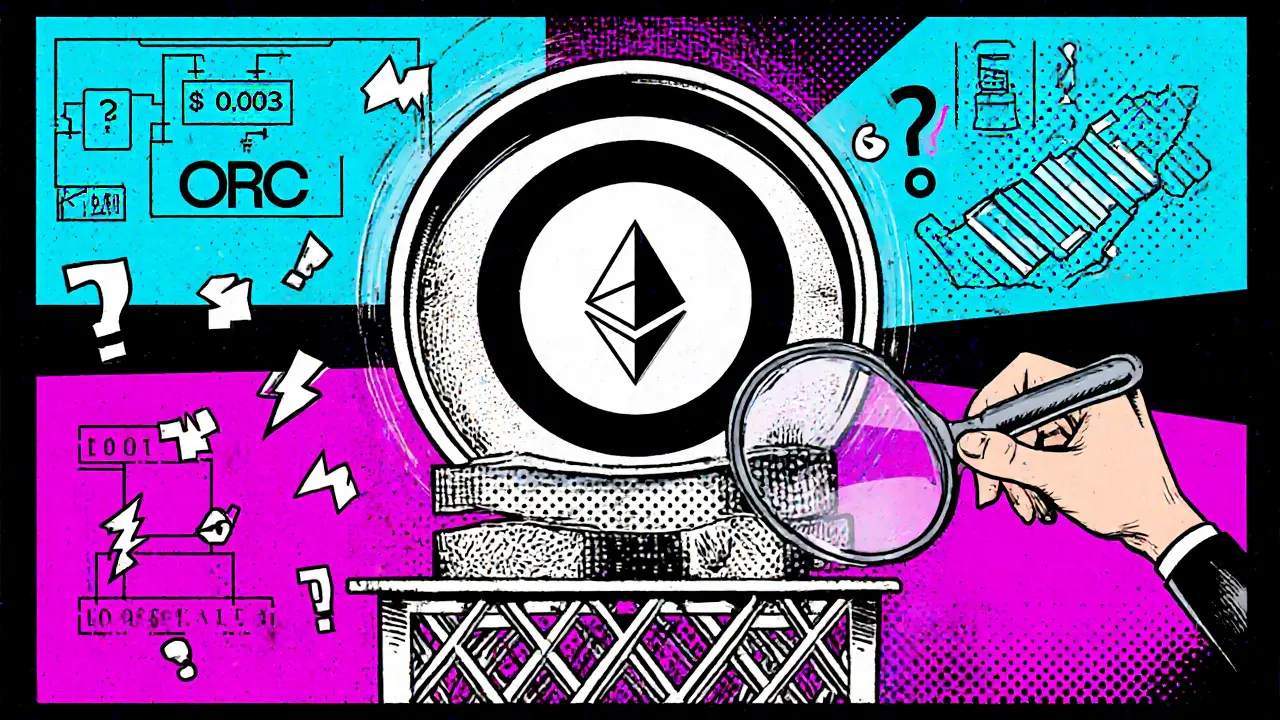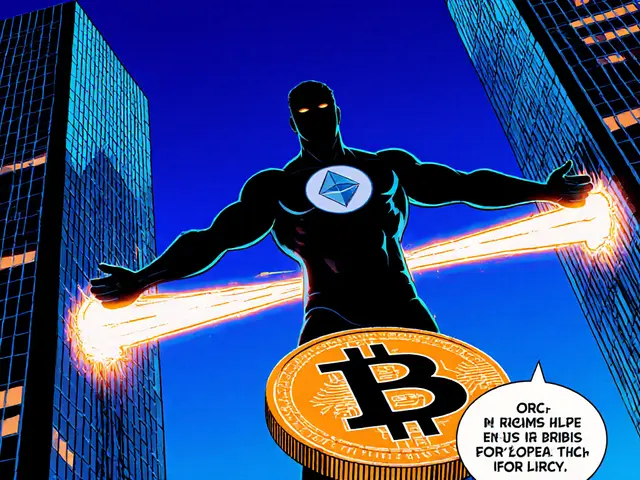ORC Recovery Calculator
Calculate Investment Recovery
See how much the ORC price needs to rise to recover your investment from the all-time high
Current ORC Data
Current Price: $0.003019
All-Time High: $4.68 (1 April 2021)
Market Cap: $2.06 million
Circulating Supply: 685.09 million ORC
Recovery Analysis
Tokens Acquired
Price Needed to Recover
Recovery Percentage
Orbit Chain is a cross‑chain blockchain project that aims to connect multiple public blockchains, allowing assets and data to move between them without the usual bottlenecks. Its native token, ORC, functions as an ERC‑20 token on Ethereum and is meant to serve as a bridge currency for the multi‑asset ecosystem. Launched around 2021, the platform positions itself as a multi‑asset infrastructure that stores, transfers, and verifies information across diverse chains. Despite the lofty vision, by October 2025 the project sits near the bottom of market‑cap rankings, trading at roughly $0.003 per token with a market cap of about $2million.
Why Cross‑Chain Interoperability Matters
Most public blockchains operate in silos. Ethereum excels at smart contracts, while Bitcoin offers robust store‑of‑value features. Users who need to move value between these ecosystems face high fees, slow confirmations, or reliance on centralized bridges. Cross‑chain interoperability promises a united landscape where assets flow freely, reducing friction for developers and traders alike.
Orbit Chain’s answer is to create a universal ledger that can verify assets on multiple chains. In theory, that means a DeFi protocol on Ethereum could lock an asset, and the same value could be represented on a Cosmos‑based chain without re‑minting. The concept mirrors what Polkadot and Cosmos do, but Orbit Chain targets a simpler, token‑centric model.
Technical Foundations
- Token standard: ORC is an ERC‑20 token (
0x662b...ef2f51) on Ethereum, which means it inherits the security and tooling of the Ethereum ecosystem. - Consensus: The public sources do not detail a unique consensus mechanism; the token relies on Ethereum’s proof‑of‑stake layer for finality.
- Bridge architecture: Orbit Chain claims to verify assets on other public blockchains, but the whitepaper and technical docs are missing, so the exact method (e.g., light clients, notarization, oracles) remains unclear.
- Supply metrics: Total supply is 947.21million ORC, with 685.09million in circulation (≈72% of max supply).
Because the project lacks a publicly audited code repository, developers must treat the bridge as a black box. That uncertainty contributes to the token’s low liquidity and market distrust.
Market Snapshot (October2025)
| Metric | Value |
|---|---|
| Current Price | $0.003019 (CoinMarketCap) |
| All‑Time High | $4.68 (1April2021) |
| Market Cap | $2.06million |
| Circulating Supply | 685.09million ORC |
| 24‑Hour Volume | $0 (CoinMarketCap) / $9,821 (CoinGecko) |
| Number of Holders | 8,170 |
| Rank by Market Cap | #1,850 |
The token has lost roughly 99.94% of its value since the 2021 peak. Trading volume is essentially nonexistent on major exchanges, indicating very thin liquidity. Such conditions make price swings unpredictable and raise the risk of slippage for anyone trying to buy or sell.

How ORC Might Be Used - Real‑World Scenarios
- Bridge Payments: A DeFi app could accept ORC as a settlement token for cross‑chain swaps, assuming the bridge functions as advertised.
- Asset Representation: Tokenizing a Bitcoin on an Ethereum‑based DEX could, in theory, be facilitated by Orbit Chain’s verification layer.
- Staking Incentives: Some projects offer ORC as a reward for providing liquidity or running a node, but no public programs are currently listed.
In practice, none of these use cases have materialized on a scale that would move the needle for price or adoption. The community is small, and there are no major exchange listings to increase visibility.
Comparison with Established Cross‑Chain Projects
| Feature | Orbit Chain (ORC) | Polkadot | Cosmos |
|---|---|---|---|
| Launch Year | 2021 | 2020 | 2019 |
| Native Token | ORC (ERC‑20) | DOT | ATOM |
| Market Cap (Oct2025) | $2M | $14.2B | $2.1B |
| Cross‑Chain Mechanism | Undocumented bridge layer | Relay chains + parachains | IBC (Inter‑Blockchain Communication) |
| Developer Ecosystem | Minimal (no public repo) | Large, active SDKs | Robust tooling, Cosmos SDK |
| Exchange Listings | None on major CEXs | Multiple top‑tier exchanges | Widely listed |
The table makes it clear why Orbit Chain is a niche player. Its market cap and ecosystem size are dwarfed by Polkadot and Cosmos, which both have well‑documented consensus models and active developer communities.
Risks and Red Flags
- Liquidity Crunch: Zero reported 24‑hour volume on CoinMarketCap means you could be stuck with tokens you can’t sell.
- Data Inconsistency: Conflicting volume figures (zero vs. $9.8k) hint at reporting issues or limited exchange presence.
- Missing Documentation: No publicly available whitepaper, GitHub repo, or audited code, which raises security concerns.
- Price Depreciation: A 99.94% drop from the 2021 high signals serious market disappointment.
- Regulatory Uncertainty: No clear compliance statements; small projects often fall through regulatory cracks.
Potential investors should treat ORC as a high‑risk speculative asset. The token’s price could swing wildly on minimal trade activity, and the bridge functionality might never see real‑world use.

How to Acquire or Store ORC Safely
- Find a Compatible Wallet: Any Ethereum‑compatible wallet that supports ERC‑20 tokens (e.g., MetaMask, Trust Wallet) can hold ORC.
- Add the Token Manually: Use the contract address
0x662b...ef2f51to add ORC to the wallet’s token list. - Purchase on Decentralized Exchanges: If you locate ORC on a DEX like Uniswap, ensure you have enough ETH for gas fees.
- Secure Your Private Keys: Because ORC is not listed on regulated exchanges, losing access to your wallet means losing the tokens forever.
Always double‑check contract addresses to avoid scam tokens that impersonate ORC.
Future Outlook - What Could Change?
Even with its current limitations, a few scenarios could improve Orbit Chain’s prospects:
- Partnership with a Major Bridge Provider: Integration with projects like Chainlink’s CCIP could add credibility.
- Release of a Public SDK: An open‑source toolkit would attract developers and spark use‑case growth.
- Listing on a Mid‑Tier Exchange: Even a small CEX listing would boost liquidity and price discovery.
Absent such developments, the token will likely remain a niche curiosity for crypto enthusiasts tracking low‑cap assets.
Frequently Asked Questions
What is the primary purpose of Orbit Chain?
Orbit Chain aims to act as a bridge that lets assets and data move between different public blockchains, reducing the need for separate, centralized bridges.
Is ORC an ERC‑20 token?
Yes. ORC follows the ERC‑20 standard on Ethereum, using contract address 0x662b...ef2f51.
Where can I trade ORC?
Currently ORC is only available on a few decentralized exchanges such as Uniswap. No major centralized exchange lists the token.
How risky is investing in ORC?
Extremely risky. The token has less than $10k daily volume, a market cap of $2million, and has lost over 99% of its value since 2021. Lack of documentation adds to the uncertainty.
What wallets support ORC?
Any wallet that can store ERC‑20 tokens works, including MetaMask, Trust Wallet, and Ledger hardware wallets. You’ll need to add the contract address manually.


Kim Evans
October 14, 2025 AT 09:06Orbit Chain (ORC) is a classic case of ambitious vision meeting harsh market reality. The idea of a cross‑chain bridge is certainly appealing, especially for developers who crave interoperability without building custom solutions. However, the lack of publicly audited code makes it difficult to assess the security of the bridge layer. Without transparent documentation, investors are left guessing whether the protocol truly verifies assets or merely pretends to. The token’s price history- a plunge of over 99% from its all‑time high- is a stark reminder of the volatility inherent in low‑cap projects. Liquidity is effectively nonexistent, meaning even modest trades can cause massive slippage. While the ERC‑20 nature of ORC allows storage in any Ethereum‑compatible wallet, that convenience does little to compensate for the missing ecosystem. The project’s roadmap offers few concrete milestones, and no major exchange listings have materialized to date. Potential partnerships with established bridge providers could inject credibility, but such collaborations have not been announced. A publicly released SDK would likely attract developers, yet the current codebase is shrouded from public view. For risk‑averse investors, the token represents a speculative bet on future development that may never occur. Conversely, curious technologists might experiment on testnets to evaluate the bridge’s functionality, but they should do so with only a small amount of capital. In short, ORC’s promise is intriguing, but the execution gaps and market indifference make it a high‑risk asset. 😊
Consider diversifying into more established cross‑chain platforms if you seek stability.
Shrey Mishra
October 19, 2025 AT 19:39The narrative surrounding Orbit Chain feels like a Shakespearean tragedy, where noble intentions are thwarted by opaque implementation. One must lament the absence of verifiable bridge mechanisms, for transparency is the lifeblood of trust in decentralized systems. The market’s cold shoulder is hardly surprising when developers cannot audit the code. Though the concept aligns with the broader vision of interoperable blockchains, execution remains an enigma wrapped in silence.
Wayne Sternberger
October 25, 2025 AT 06:13Indeed, the silence is deafening and the documentation is, defiantly, missing. One would expect at least a repo on GitHub, yet the project remains a specter in the ether. It is, quite frankly, defnitely a red flag for any serious invester.
Jennifer Bursey
October 30, 2025 AT 16:46From a technical standpoint, the jargon‑heavy claims of “universal ledger verification” lack substance without concrete proofs. Assertions of cross‑chain asset representation sound impressive, but without a disclosed architecture, they remain lofty buzzwords. This gap between hype and reality is why many view ORC as a niche curiosity rather than a serious contender.
Lesley DeBow
November 5, 2025 AT 03:19Philosophically, we confront the paradox of a bridge that is everywhere yet nowhere. The promise of seamless movement across chains invites contemplation of connectivity, but the missing scaffolding undermines the very essence of trust. In the end, the project serves as a reminder that ideas without evidence remain mere speculation.
Teagan Beck
November 10, 2025 AT 13:53Honestly, it’s a bit wild how a token can still float around with that kind of volume-or lack thereof. If you’re just looking to store it, any ERC‑20 wallet will do, but don’t expect any fireworks.
EDMOND FAILL
November 16, 2025 AT 00:26Looking at the data, the market cap sits at a humble $2 million, which is tiny compared to Polkadot’s billions. The token’s trading volume is almost zero, so you’ll likely face huge slippage if you try to move large amounts. It’s a classic example of a project that never gained real traction.
Maureen Ruiz-Sundstrom
November 21, 2025 AT 10:59This token is a joke. No substance, no use‑case, just empty promises.
Kevin Duffy
November 26, 2025 AT 21:33Hey everyone! Keep your chin up-if you’re curious about cross‑chain tech, there are plenty of vibrant ecosystems out there. 🌟 Even if ORC isn’t soaring, the space is still full of opportunity!